Sonova USA WHSITE1 Hearing Aid User Manual User Guide
Phonak Inc Hearing Aid User Guide
User Guide

Manufacturer:
Phonak AG
Laubisrütistrasse 28
CH-8712 Stäfa
Switzerland
EU Representative:
Phonak GmbH
D-70736 Fellbach-Oeffingen
Germany
www.phonak.com
029-1007-02/2010-08/A+W/FO Printed in Switzerland
©Phonak AG All rights reserved
0459
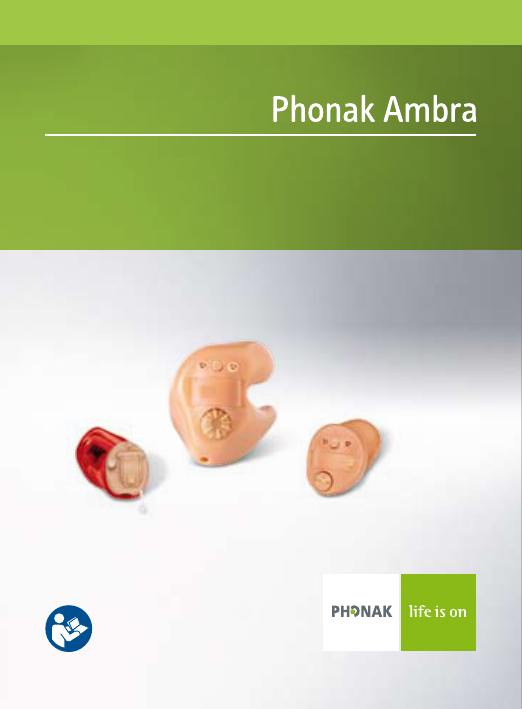
Custom in-the-ear hearing system
User Guide

2
1. Welcome 4
2. Important information:
Please read before operating your hearing
system for the first time 6
Hazard warnings 6
Information on product safety 8
3. Hearing system description 10
4. Step-by-step instructions for using
the hearing system 13
Step 1. Getting to know your hearing system 13
Step 2. Battery preparation 16
Step 3. Inserting the battery 16
Step 4. Turning on the hearing system 17
Step 5. Inserting the hearing system 18
Step 6. Adjusting the volume control
in the ear 20
Step 7. Selecting the hearing program
in the ear 22
Contents

3
Step 8. Removing the hearing system 23
Step 9. Turning off the hearing system 25
Step 10. Changing the battery 25
5. Care and maintenance 26
6. Troubleshooting 29
7. Wireless Accessories and FM systems 31
8. Service and warranty 33
9. Compliance information 34
10. Information and explanation of symbols 37

4
1. Welcome
Your new hearing system is a premium Swiss quality
product. It was developed by Phonak, one of the
world‘s leading companies in hearing technology. Your
hearing system offers the most modern digital hearing
technology currently available on the market.
Phonak has implemented this hearing technology into
hearing systems that are simple and easy to use. Many
automatic functions offer maximum sound quality,
the highest speech clarity, and optimal hearing comfort
in almost all hearing situations. We are convinced
that the outstanding performance of your hearing system
will provide valuable benefits to your daily life.
Please read these user instructions thoroughly in order
to benefit from all the possibilities your new hearing
system has to offer. With proper use and care, you will
be able enjoy your hearing system for many years to
come.

5
If you have any questions, please consult your hearing
care professional.
Phonak - life is on www.phonak.com
0459

6
Please read the information on the following pages
before using your hearing system.
A hearing system will not restore normal hearing
and will not prevent or improve a hearing impairment
resulting from organic conditions. Infrequent use
of a hearing system does not permit a user to attain
full benefit from it. The use of a hearing system is
only part of hearing habilitation and may need to be
supplemented by auditory training and instruction
in lipreading.
2.1 Hazard warnings
Use only hearing systems that have been specially
programmed for you by your hearing care pro-
fessional. Other systems may be ineffective and
may, in certain cases, damage your hearing.
Changes or modifications to the hearing system that
were not explicitly approved by Phonak are not
permitted. Such changes may damage your ear or
the hearing system.
2. Important information

7
Hearing system batteries are toxic if they are
swallowed! Keep out of reach of children and pets.
If batteries are swallowed, consult your medical
physician immediately!
If you feel pain in or behind your ear, if it is inflamed
or if skin irritation and accelerated accumulations
of ear wax occur, please check with your hearing care
professional or physician.
Hearing programs in the directional microphone
mode reduce background noises. Please be aware
that warning signals or noises coming from behind,
e. g. cars, are partially or entirely suppressed.
The hearing system contains small parts which can
be swallowed by children.
External devices may only be connected if they have
been tested in accordance with corresponding
IECXXXXX standards. Only use accessories approved
by Phonak AG.

8
2.2 Information on product safety
Never immerse your hearing system in water!
Protect it from excessive moisture. Always remove
your hearing system before showering, bathing,
or swimming.
Protect your hearing system from the heat (never
leave it near a window or in the car). Never use
a microwave or other heating devices to dry your
hearing system. Ask your hearing care professional
about suitable drying methods.
When you are not using your hearing system, leave
the battery compartment open so that any moisture
can evaporate. Make sure that you always completely
dry your hearing system after use. Store the hearing
system in a safe, dry and clean place.
Do not drop your hearing system! Dropping onto a
hard surface can damage your hearing system.
2. Important information

9
Always use new batteries for your hearing system.
You can return used batteries to your hearing care
professional.
Remove the battery if you are not using your hearing
system for a long period of time.
X-ray radiation (e. g. CT scans, MRI scans) may
adversely affect the correct functioning of your
hearing systems. We recommend that you remove
them before undergoing X-ray procedures and
keep them outside the room.
Do not use your hearing system in areas where
electronic equipment is prohibited.

10
The following user instructions describe three hearing
system models: CIC/MC (Completely in the canal/Mini
canal) models that sit deep in the ear canal, ITC/HS (In
the canal/Half shell) models that are situated in the
ear canal or in the bowl of the ear, and FS (Full shell)
models that are situated only in the bowl of the ear.
On the following pages use the labeled drawings to
identify the hearing system that you use.
Please note: specific functions described on the
following pages may not be included in your model
because some model features are optional.
Your hearing care professional will tell you what size
battery you need for your hearing system.
3. Hearing system description
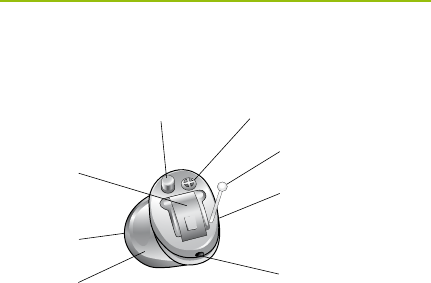
11
CIC/MC-model
a Custom made shell
b Receiver (sound outlet) and wax protection system
c Battery compartment with ON/OFF switch
d Program switch (optional)*
e Protected microphone inlet
f Removal handle (CIC/MC)
g Right or left indicator (right=red, left=blue)
h Vent
* A volume control is also optional; it is not shown here.
a
b
c
d e
f
h
g
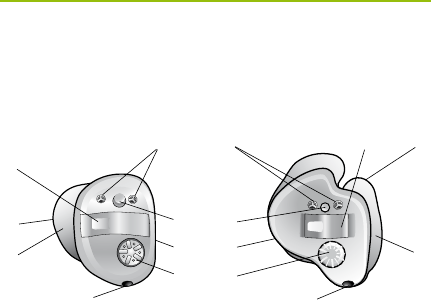
12
ITC/HS-model FS-model
a Custom made shell
b Receiver (sound outlet) and wax protection system
c Battery compartment with ON/OFF switch
d Protected microphone inlets
(number of inlets is optional)
e Program switch (optional)
f Right or left indicator (right=red, left=blue)
g Volume control (optional)
h Vent
3. Hearing system description
a
b
c
e
d
h
g
a
bc
e
d
g
h
f f

13
The following chapter provides step-by-step instructions
on how to use your hearing system. Please follow these
steps carefully. In the drawings, the parts that are parti-
cularly important for each step are shown in green.
Step 1. Getting to know your hearing system
Take the hearing instrument in your hand and try out
the hearing system controls. This will make it easier
for you to feel for and operate the controls later on
when wearing the hearing system.
4. Step-by-step instructions for using
the hearing system
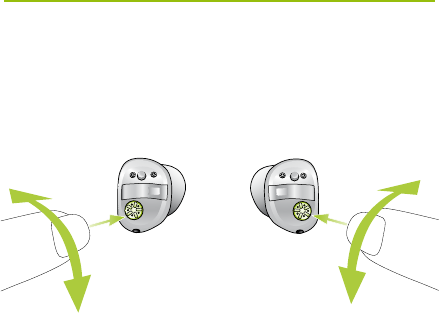
14
4. Using the hearing system
Turn the volume control to change the volume (Fig 1a).
left ear right ear
The direction you have to turn the volume control
when wearing the system in the ear is shown in step 6
in this section.
Fig. 1a
louder
softer
louder
softer
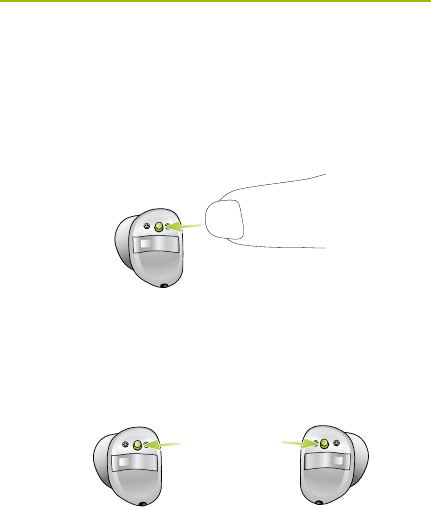
15
Your hearing care professional can configure your
hearing system (push) switch as either a volume
control or a program selector.
In order to change a hearing program, press the
switch displayed (Fig. 1b).
To increase the volume, press the switch on your right
hearing system. To decrease the volume, press the
switch on your left hearing system* (Fig. 1c).
Decrease volume Increase Volume
Left hearing system Right hearing system
*Only available for wireless products
Fig. 1b
Fig. 1c
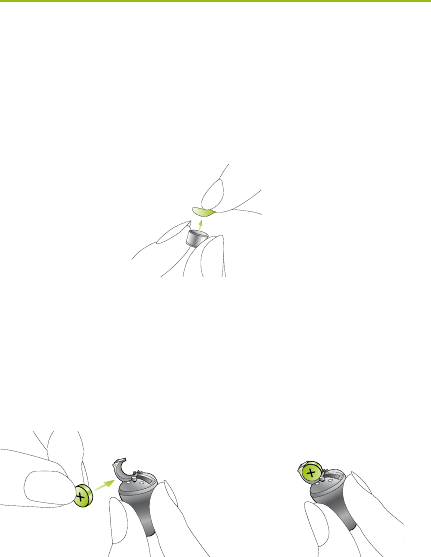
16
Step 2. Battery preparation
Remove the protective foil from the new battery (Fig. 2).
Wait for two minutes before inserting to activate the
battery.
Step 3. Inserting the battery
Take the hearing system in your hand (Fig. 3a) and
open the battery door. Insert the battery so that you
see the + symbol on the battery (Fig. 3b).
Fig. 3a Fig. 3b
4. Using the hearing system
Fig. 2
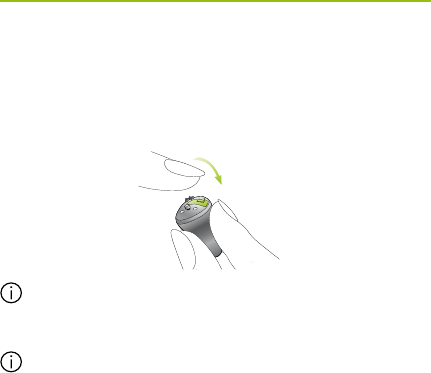
17
Step 4. Turning on the hearing system
Switch on the hearing system by closing the battery
compartment (Fig. 4).
Open and close the battery compartment gently
and carefully.
If you feel resistance when closing the battery
compartment, check to make sure the battery is
correctly inserted and in the correct direction.
If the battery is inserted the wrong way, the
hearing system will not work and the battery
compartment can be damaged.
The hearing system is now switched on. It can take up
to 15 seconds before it starts.
(When you wear the hearing system, you will hear an
acoustic signal).
Fig. 4

18
Step 5. Inserting the hearing system
This step shows you how to correctly insert the hearing
system.
Each hearing system is individually programmed
for your right or left ear. For the first step
identify right and left so you will be able to insert
your hearing system in the correct ear.
Step 5.1 Identifying the hearing systems for the right
and left ear
The color mark is located on the shell (the text is
printed in red or blue):
right = red
left = blue
Fig. 5a
4. Using the hearing system
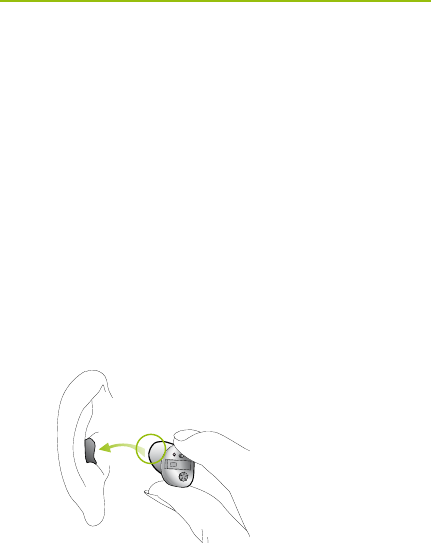
19
Step 5.2 Inserting the hearing system (all models)
With your right hand, take your hearing system for the
right ear (red mark on the hearing system, see step 5.1)
between your thumb and forefinger (Fig. 5b).
Insert the tip of the hearing system into the ear canal
(see the part circled in green in Fig. 5b). Carefully pull
on your earlobe and push the hearing system into the
correct position. Ensure that it is positioned securely. In
the beginning, please use a mirror to check.
Fig. 5b
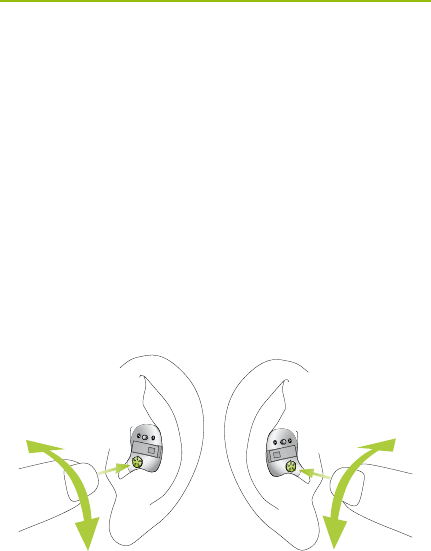
20
You have now successfully inserted the right hearing
system. Now insert your left hearing system in the
same way (marked in blue, see step 5.1)
Step 6. Adjusting the volume in the ear
To increase the volume (possible only on models with
an optional volume control), turn the volume control
forward. To decrease it, turn the volume control back-
ward using your forefinger (Fig. 6a).
Left ear Right ear
Fig. 6a
Louder
Softer
Louder
Softer
4. Using the hearing system
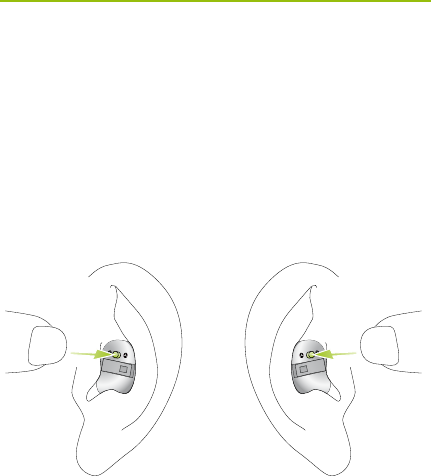
21
Your hearing care professional can configure your
hearing system (push) switch as either a volume control
or a program selector.
To increase the volume, press the switch on your
right hearing system. To decrease the volume, press
the switch on your left hearing system.
Decrease volume Increase volume
Left hearing system Right hearing system
Fig. 6b
*Only available for wireless products
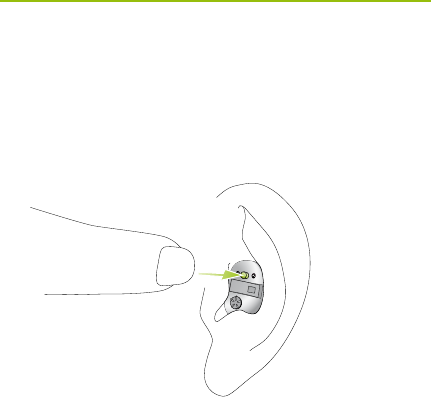
22
Step 7. Selecting the hearing program in the ear
To change a hearing program (possible only in models
with an optional program switch), press the program
switch shown (Fig. 7).
If you press it again, you change to the next program.
A signal indicates the change.
A signal tone can only be easily heard if you have turned
on the hearing system and you are wearing it correctly
in the ear.
Fig. 7
4. Using the hearing system
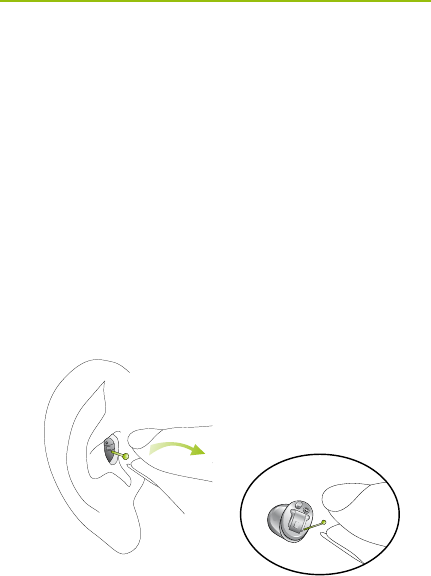
23
Step 8. Removing the hearing system
The following steps describe how to easily remove the
hearing system either with or without the removal
line.
Step 8.1 Removing the hearing system with a removal
handle
Hold the removal handle between the thumb and index
finger, and carefully pull the hearing system up and out
of the ear (Fig. 8a).
Fig. 8a
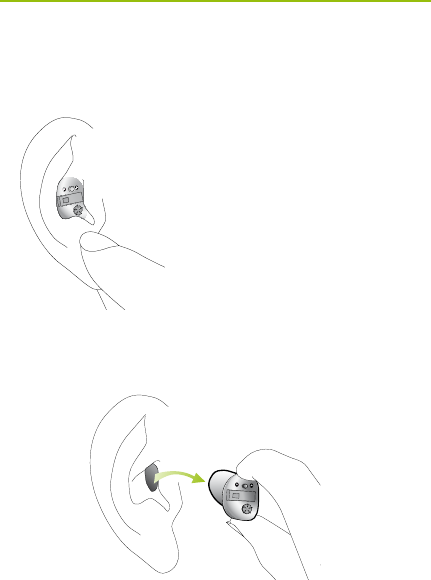
24
4. Using the hearing system
Step 8.2 Removing the hearing system without a
removal handle
Put your thumb behind your
lobe (directly behind the hard
cartilage, Fig. 8b) and gently
press your ear upward to push
the hearing system out of the
canal. In order to help it along,
make chewing movements
with your jaw.
Grasp the protruding hearing system and remove it,
(Fig. 8c).
Fig. 8b
Fig. 8c
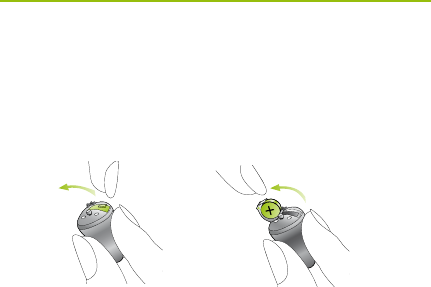
25
Step 9. Turning off the hearing system
You can turn off your hearing system by opening the
battery compartment (Fig. 9).
Step 10. Changing the battery
Before the battery is completely empty, your hearing
system will indicate to you that the battery soon needs
to be changed with an acoustic signal. Once this
happens, you have about 30 minutes (in some cases
longer) to change the battery. The battery warning
signal is repeated every half hour. We recommend that
you always keep a spare battery on hand.
Fig. 9

26
5. Care and maintenance
Diligent and routine care of your hearing system
contributes to outstanding performance and a long
service life.
Please use the following specifications as a guideline:
General information
Before using hair spray or applying cosmetics, you
should remove your hearing system from your ear,
because these products may damage it.

27
Daily
Daily cleaning and the use of a drying system is highly
recommended. “C&C line” from Phonak is a complete
set of cleaning products. Your hearing care professional
will be glad to advise you. Never use household cleaning
products (washing powder, soap, etc.) to clean your
hearing systems.
If your hearing system is performing weakly or fails to
operate, clean or replace the wax guard system. If your
hearing system fails to operate after you have correctly
cleaned or replaced your wax protection system and
inserted new batteries, contact your hearing care pro-
fessional for advice.
Weekly
For more in depth maintenance instructions or for
more than basic cleaning, please see your hearing care
professional.
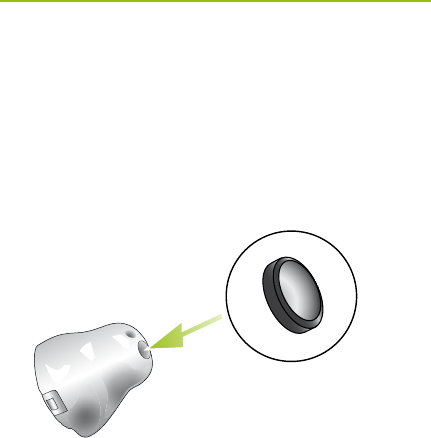
28
5. Care and maintenance
SmartGuard (optional)
SmartGuard is a unique wax protection system
developed by Phonak. The unique membrane design
completely protects your hearing system from wax
and moisture.
Please ask your hearing care professional for further
information.
Fig. 10

29
Hearing systems sound softer than usual / no sound
Clean the wax protection system or replace it. Check
whether the battery is correctly inserted and properly
fitted, adjust the fit if necessary. If there is no improve-
ment, change the battery. If the problem persists,
contact your hearing care professional.
Battery discharges too quickly
Insert a new battery and make note of exactly how
long it lasts. Contact your hearing care professional
with this information, they will be able to help and
advise you.
Crackling or buzzing noises
Check for residue due to ear wax. Then try a new
battery. If the problem persists, contact your hearing
care professional.
6. Troubleshooting

30
Whistling
Check whether the hearing system is correctly and
firmly fitted. If this is the case, but the problem persists,
please consult with your hearing care professional.
Pain or inflammation in your ear
Remove the hearing system and consult with your
hearing care professional. If the problem is serious,
please contact your physician.
6. Troubleshooting

31
7.1 Wireless accessories*
Phonak has developed a broad range of wireless
accessories that allow you to best use and discreetly
control your hearing system. These include, for
example, remote controls, wireless connection modules
to the TV and computer, and much more. Programs
and accessories that can help you make phone calls
simply and more comfortably are also included in
this product range.
7.2 FM Systems*
FM Systems are wireless communication systems
consisting of a radio transmitter and a radio receiver.
The transmitter is placed close to the sound source
(e. g. TV/Radio/lectern). The sound is transmitted clearly
and directly to the hearing system in the form of
radio signals – without disruptive background noises
or echoes.
Phonak is a leader in FM communication. In order
to take advantage of the benefits of these high-tech
radio systems, consult with your hearing care pro-
fessional.
7. Wireless Accessories and FM systems

32
If you already have an FM system and need additional
information on using this system, please consult the
relevant user instructions on the FM transmitter or the
FM receiver.
For more information, please visit www.phonak.com,
or ask your hearing care professional.
* Possible only for models with this option integrated,
check with your hearing professional.
7. Wireless Accessories and FM systems

33
8. Service and warranty
Phonak offers you a comprehensive, worldwide warranty,
valid starting from the date of purchase. Please ask
your hearing care professional about the term of the
warranty valid in the country of purchase. The warranty
covers repairs in case of processing and material errors.*
No warranty claims will be considered if the hearing
system shows normal wear and tear, improper handling
or care, exposure to chemicals, immersion in water or
undue stress. In case of damage caused by third parties
or non-authorized service, the Phonak warranty is
null and void. This warranty does not cover services
performed by a hearing care professional at his or
her workplace.
Serial number of the Serial number of the
left hearing system right hearing system
Purchase date:
*Contact your hearing care professional

34
Declaration of Conformity
Hereby Phonak AG declares that this Phonak product
meets the requirements of the Medical Devices Directive
93/42/EEC as well as the Radio and Telecommunications
Terminal Equipment Directive 1999/5/EC. The full text of
the Declaration of Conformity can be obtained from
the manufacturer.
9. Compliance information

35
The hearing instrument described in this user guide is
certified under:
USA FCC ID: KWC-WHSITE1
Canada IC: 2262A-WHSITE1
Notice 1:
This device complies with Part 15 of the FCC Rules and
with RSS-210 of Industry Canada. Operation is subject
to the following two conditions:
1) this device may not cause harmful interference, and
2) this device must accept any interference received,
including interference that may cause undesired
operation.
Notice 2:
Changes or modifications made to this device not
expressly approved by Phonak may void the FCC
authorization to operate this device.

36
Notice 3:
This device has been tested and found to comply with
the limits for a Class B digital device, pursuant to Part
15 of the FCC Rules and ICES-003 of Industry Canada.
These limits are designed to provide reasonable protection
against harmful interference in a residential installation.
This device generates, uses and can radiate radio
frequency energy and, if not installed and used in
accordance with the instructions, may cause harmful
interference to radio communications. However, there
is no guarantee that interference will not occur in a
particular installation. If this device does cause harmful
interference to radio or television reception, which can
be determined by turning the equipment off and on, the
user is encouraged to try to correct the interference
by one or more of the following measures:
J Reorient or relocate the receiving antenna.
J Increase the separation between the device and
receiver.
J Connect the device into an outlet on a circuit different
from that to which the receiver is connected.
J Consult the dealer or an experienced radio/TV technician
for help.
9. Compliance information
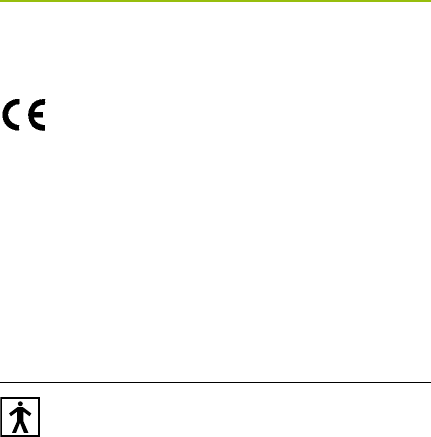
37
With the CE symbol, Phonak AG
confirms that this Phonak product –
including accessories – meets
the requirements of the Medical
Devices Directive 93/42/EEC as well
as the R&TTE Directive 1999/5/EC
on radio and telecommunications
transmitters. The numbers after the
CE symbol correspond to the code
of certified institutions that were
consulted under the above-mentioned
directives.
This symbol indicates that the pro-
ducts described in these user instruc-
tions adhere to the requirements for
an application part of Type BF of
EN 60601-1. The surface of the hearing
system is specified as application part
of Type BF.
XXXX
10. Information and description of
symbols
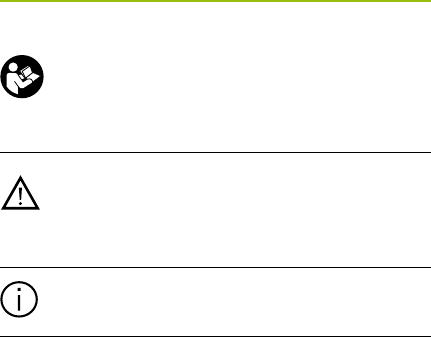
38
This symbol indicates that it is
important for the user to read and
take into account the relevant
information in these user guides.
This symbol indicates that it is
important for the user to pay
attention to the relevant warning
notices in these user guides.
Important information for handling
and product safety.
The product is designed such that
it functions without problems or
restrictions if used as intended, unless
otherwise noted in these user guides.
Operating
conditions
10. Information and description of symbols

During transport or storage, the
temperature should not exceed the
limit values of –20°/60° Celsius and
relative humidity of 65% for a long
period of time. The air pressure –
range between 500 and 1100 hPa is
appropriate.
The symbol with the crossed-out
garbage bin is to make you aware
that this hearing system may not be
thrown away as normal household
waste. Please dispose of old or
unused hearing systems, at waste
disposal sites intended for electronic
waste, or give your hearing system
to your hearing care professional for
disposal. Proper disposal protects
the environment and health.
Transport
and storage
conditions

40
Warning to Hearing Aid Dispensers
A hearing aid dispenser should advise a prospective
hearing aid user to consult promptly with a licensed
physician (preferably an ear specialist) before dispensing
a hearing aid if the hearing aid dispenser determines
through inquiry, actual observation, or review of any
other available information concerning the prospective
user, that the prospective user has any of the following
conditions:
(i) Visible congenital or traumatic deformity of
the ear.
(ii) History of active drainage from the ear within
the previous 90 days.
(iii) History of sudden or rapidly progressive hearing
loss within the previous 90 days.
(iv) Acute or chronic dizziness.
(v) Unilateral hearing loss of sudden or recent onset
within the previous 90 days.
(vi) Audiometric air-bone gap equal to or greater
than 15 decibels at 500 hertz (Hz), 1,000 Hz, and
2,000 Hz.
For the US market only, complies
with the FDA regulations

41
(vii) Visible evidence of significant cerumen
accumulation or a foreign body in the ear canal.
(viii) Pain or discomfort in the ear. Special care should
be exercised in selecting and fitting a hearing
aid whose maximum sound pressure level exceeds
132 decibels because there may be risk of
impairing the remaining hearing of the hearing
aid user. (This provision is required only for
those hearing aids with a maximum sound pressure
capability greater than 132 decibels (dB).)
Important Notice for Prospective
Hearing Aid Users
Good health practice requires that a person with a
hearing loss have a medical evaluation by a licensed
physician (preferably a physician who specializes
in diseases of the ear) before purchasing a hearing aid.
Licensed physicians who specialize in diseases of the
ear are often referred to as otolaryngologists, otologists
or otorhinolaryngologists. The purpose of medical
evaluation is to assure that all medically treatable

42
conditions that may affect hearing are identified
and treated before the hearing aid is purchased.
Following the medical evaluation, the physician will
give you a written statement that states that your
hearing loss has been medically evaluated and that
you may be considered a candidate for a hearing
aid. The physician will refer you to an audiologist or
a hearing aid dispenser, as appropriate, for a hearing
aid evaluation.
The audiologist or hearing aid dispenser will conduct
a hearing aid evaluation to assess your ability to hear
with and without a hearing aid. The hearing aid
evaluation will enable the audiologist or dispenser to
select and fit a hearing aid to your individual needs.
If you have reservations about your ability to adapt to
amplification, you should inquire about the availability
of a trial-rental or purchase-option program. Many
hearing aid dispensers now offer programs that permit
you to wear a hearing aid for a period of time for a
nominal fee after which you may decide if you want to
purchase the hearing aid.
For US market only

43
Federal law restricts the sale of hearing aids to those
individuals who have obtained a medical evaluation
from a licensed physician. Federal law permits a fully
informed adult to sign a waiver statement declining
the medical evaluation for religious or personal beliefs
that preclude consultation with a physician. The
exercise of such a waiver is not in your best health
interest and its use is strongly discouraged.
Children with Hearing Loss
In addition to seeing a physician for a medical
evaluation, a child with a hearing loss should be
directed to an audiologist for evaluation and
rehabilitation since hearing loss may cause problems
in language development and the educational and
social growth of a child. An audiologist is qualified by
training and experience to assist in the evaluation
and rehabilitation of a child with a hearing loss.

44
Notes
45